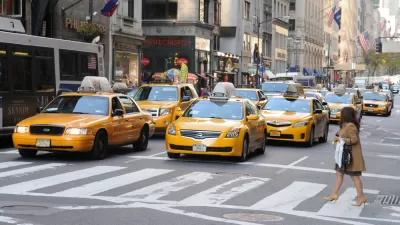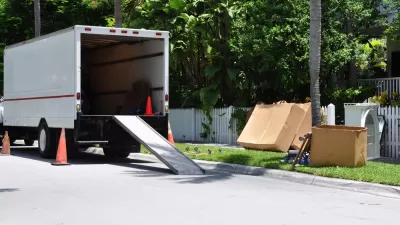Americans are less mobile than they were decades ago and it's unclear why. Possible explanations include the recession, habits based on family make-up, as well as telecommuting and job trends, but none of these proposed reasons can be easily proven.
According to recently released U.S. Census data [PDF] from the Current Population Survey, American mobility rates are at an all time low. “About 100 million people (aged 5 and up) lived in a different home or apartment in 2010 than they did in 2005” reports Eric Jaffe, “[b]ut that total is down from 107 million movers between 2000 and 2005, and the latest mobility rate is 10 points off the peak rate back in the mid-1970s.” The Census explains who is moving and where they are moving to, but not why.
"At the Conversable Economist, Timothy Taylor points us to a 2011 study that found America's declining mobility to be a bit of an ongoing mystery. That study considers a number of theories, but finds each of them flawed. It concludes [PDF]: "By most measures, internal migration in the United States is at a 30-year low. Migration rates have fallen for most distances, demographic and socioeconomic groups, and geographic areas. The widespread nature of the decrease suggests that the drop in mobility is not related to demographics, income, employment, labor-force participation, or homeownership."
"At the end of the day, writes Taylor, Americans might just be 'shifting their preferences away from being willing to move.'"
FULL STORY: The Mystery of Our Declining Mobility

Maui's Vacation Rental Debate Turns Ugly
Verbal attacks, misinformation campaigns and fistfights plague a high-stakes debate to convert thousands of vacation rentals into long-term housing.

Planetizen Federal Action Tracker
A weekly monitor of how Trump’s orders and actions are impacting planners and planning in America.

San Francisco Suspends Traffic Calming Amidst Record Deaths
Citing “a challenging fiscal landscape,” the city will cease the program on the heels of 42 traffic deaths, including 24 pedestrians.

Defunct Pittsburgh Power Plant to Become Residential Tower
A decommissioned steam heat plant will be redeveloped into almost 100 affordable housing units.

Trump Prompts Restructuring of Transportation Research Board in “Unprecedented Overreach”
The TRB has eliminated more than half of its committees including those focused on climate, equity, and cities.

Amtrak Rolls Out New Orleans to Alabama “Mardi Gras” Train
The new service will operate morning and evening departures between Mobile and New Orleans.
Urban Design for Planners 1: Software Tools
This six-course series explores essential urban design concepts using open source software and equips planners with the tools they need to participate fully in the urban design process.
Planning for Universal Design
Learn the tools for implementing Universal Design in planning regulations.
Heyer Gruel & Associates PA
JM Goldson LLC
Custer County Colorado
City of Camden Redevelopment Agency
City of Astoria
Transportation Research & Education Center (TREC) at Portland State University
Jefferson Parish Government
Camden Redevelopment Agency
City of Claremont





























